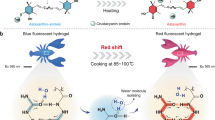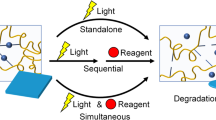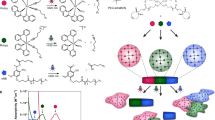Abstract
Photoinitiated free radical polymerization (PFRP) is favoured for its simplicity and rapid processing, but typically yields heterogeneous networks with densely crosslinked nanoclusters embedded in a loosely connected matrix, leading to structural weaknesses and mechanical deterioration. Here we incorporate a photocoupling reaction into PFRP systems to convert weakly interconnected nanoclusters into a robust, interlinked network, facilitating effective load transfer between soft and hard phases and enhancing the mechanical properties. This is achieved by partially substituting vinyl moieties with o-nitrobenzyl groups, which generate nitroxides upon photoirradiation with a temporal delay. This allows nanoclusters to form initially, and then enables propagating radicals to couple efficiently within them. Hydrogels synthesized via this approach demonstrate boosted tensile strength up to 20-fold and toughness up to 70-fold compared with PFRP methods, and still gelate within seconds. This strategy demonstrates versatility across various systems and offers a scalable approach for producing high-performance hydrogels and polymer networks.

This is a preview of subscription content, access via your institution
Access options
Subscribe to this journal
Receive 12 digital issues and online access to articles
$119.00 per year
only $9.92 per issue
Buy this article
- Purchase on SpringerLink
- Instant access to full article PDF
Prices may be subject to local taxes which are calculated during checkout







Similar content being viewed by others
Data availability
All data supporting the findings of this study are available within the Article and its Supplementary Information. Source data are provided with this paper.
References
Gao, Y. et al. Complex polymer architectures through free-radical polymerization of multivinyl monomers. Nat. Rev. Chem. 4, 194–212 (2020).
Liu, S. The future of free radical polymerizations. Chem. Mater. 36, 1779–1780 (2024).
Odian, G. Principles of Polymerization 4th edn (Wiley, 2004).
Somers, P. et al. The physics of 3D printing with light. Nat. Rev. Phys. 6, 99–113 (2024).
Corrigan, N. & Boyer, C. In the limelight: 2D and 3D materials via photo-controlled radical polymerization. Trends Chem. 2, 689–706 (2020).
Dhand, A. P. et al. Simultaneous one-pot interpenetrating network formation to expand 3D processing capabilities. Adv. Mater. 34, 2202261 (2022).
Yue, K. et al. Synthesis, properties, and biomedical applications of gelatin methacryloyl (gelMA) hydrogels. Biomaterials 73, 254–271 (2015).
Xu, Y. et al. In-situ transfer vat photopolymerization for transparent microfluidic device fabrication. Nat. Commun. 13, 918 (2022).
Berman, A. et al. Additively manufactured micro-lattice dielectrics for multiaxial capacitive sensors. Sci. Adv. 10, eadq8866 (2024).
Wang, M. et al. Glassy gels toughened by solvent. Nature 631, 313–318 (2024).
Zhang, A. et al. Applications of synthetic polymers directed toward living cells. Nat. Synth. 3, 943–957 (2024).
Choong, Y. Y. C. et al. The global rise of 3D printing during the COVID-19 pandemic. Nat. Rev. Mater. 5, 637–639 (2020).
Matsumoto, A. Free-radical crosslinking polymerization and copolymerization of multivinyl compounds. Adv. Polym. Sci. 123, 41–80 (1995).
Seiffert, S. Origin of nanostructural inhomogeneity in polymer-network gels. Polym. Chem. 8, 4472–4487 (2017).
Shibayama, M. Spatial inhomogeneity and dynamic fluctuations of polymer gels. Macromol. Chem. Phys. 199, 1–30 (1998).
Seiffert, S. Scattering perspectives on nanostructural inhomogeneity in polymer network gels. Prog. Polym. Sci. 66, 1–21 (2017).
Gu, Y., Zhao, J. & Johnson, J. A. A (macro)molecular-level understanding of polymer network topology. Trends Chem. 1, 318–334 (2019).
Sato, K. et al. Phase-separation-induced anomalous stiffening, toughening, and self-healing of polyacrylamide gels. Adv. Mater. 27, 6990–6998 (2015).
Bai, R., Yang, J. & Suo, Z. Fatigue of hydrogels. Eur. J. Mech. A 74, 337–370 (2019).
Zhao, X. et al. Soft materials by design: unconventional polymer networks give extreme properties. Chem. Rev. 121, 4309–4372 (2021).
Means, A. K. & Grunlan, M. A. Modern strategies to achieve tissue-mimetic, mechanically robust hydrogels. ACS Macro Lett. 8, 705–713 (2019).
Richbourg, N. R. & Peppas, N. A. Structurally decoupled stiffness and solute transport in multi-arm poly(ethylene glycol) hydrogels. Biomaterials 301, 122272 (2023).
Kamata, H. et al. “Nonswellable” hydrogel without mechanical hysteresis. Science 343, 873–875 (2014).
Liu, C. et al. Tough hydrogels with rapid self-reinforcement. Science 372, 1078–1081 (2021).
Li, X. & Gong, J. P. Design principles for strong and tough hydrogels. Nat. Rev. Mater. 9, 380–398 (2024).
Hua, M. et al. Strong tough hydrogels via the synergy of freeze-casting and salting out. Nature 590, 594–599 (2021).
Chen, M. et al. Living additive manufacturing: transformation of parent gels into diversely functionalized daughter gels made possible by visible light photoredox catalysis. ACS Cent. Sci. 3, 124–134 (2017).
Wu, Z. et al. Photo-RAFT polymerization for hydrogel synthesis through barriers and development of light-regulated healable hydrogels under NIR irradiation. Angew. Chem. Int. Ed. 62, e202302451 (2023).
Chen, M., Zhong, M. & Johnson, J. A. Light-controlled radical polymerization: mechanisms, methods, and applications. Chem. Rev. 116, 10167–10211 (2016).
Yu, Q. et al. Reaction behavior and network development in RAFT radical polymerization of dimethacrylates. Macromol. Chem. Phys. 209, 551–556 (2008).
Henkel, R. & Vana, P. The influence of RAFT on the microstructure and the mechanical properties of photopolymerized poly(butyl acrylate) networks. Macromol. Chem. Phys. 215, 182–189 (2014).
Wang, R. et al. Modeling of branching and gelation in RAFT copolymerization of vinyl/divinyl systems. Macromolecules 42, 85–94 (2009).
Nonoyama, T. & Gong, J. P. Tough double network hydrogel and its biomedical applications. Annu. Rev. Chem. Biomol. Eng. 12, 393–410 (2021).
Sun, J. Y. et al. Highly stretchable and tough hydrogels. Nature 489, 133–136 (2012).
Gong, J. P. Why are double network hydrogels so tough? Soft Matter 6, 2583–2590 (2010).
Wright, P. J. & English, A. M. Scavenging with TEMPO to identify peptide-and protein-based radicals by mass spectrometry: advantages of spin scavenging over spin trapping. J. Am. Chem. Soc. 125, 8655–8665 (2003).
Bagryanskaya, E. G. & Marque, S. R. A. Scavenging of organic C-centered radicals by nitroxides. Chem. Rev. 114, 5011–5056 (2014).
Klán, P. et al. Genetically encoded residue-selective photo-crosslinker to capture protein–protein interactions in living cells. Chem. Rev. 113, 119–191 (2013).
Hawkins, C. L. & Davies, M. J. Detection and characterisation of radicals in biological materials using EPR methodology. Biochim. Biophys. Acta 1840, 708–721 (2014).
Polanowski, P., Jeszka, J. K. & Matyjaszewski, K. Modeling of branching and gelation in living copolymerization of monomer and divinyl cross-linker using dynamic lattice liquid model (DLL) and Flory–Stockmayer model. Polymer 51, 6084–6092 (2010).
Song, N. et al. Tailoring nanocomposite interfaces with graphene to achieve high strength and toughness. Sci. Adv. 6, eaba7016 (2020).
Harrington, M. J. et al. Iron-clad fibers: a metal-based biological strategy for hard flexible coatings. Science 328, 216–220 (2010).
Acknowledgements
This work was financially supported by the National Key Research and Development Program of China (2024YFA1107600), the 173 Plan Project (2019-JCJQ-ZD-359-00), the National Natural Science Foundation of China (32121005 and 22475129) and the Interdisciplinary Program of Shanghai Jiao Tong University (YG2022ZD017, YG2023ZD16).
Author information
Authors and Affiliations
Contributions
Q.L. and L.Z. conceived the ideas. B.B., C.S., Q.Z. and T.C. were responsible for the experimental concept, design and data analysis. B.B., C.S., Q.Z., T.C., C.X. and T.L. prepared materials, performed the mechanical tests and analysed the data. B.B., C.S. and L.J. performed the structural characterization and analysed the data. J.L. and W.W. performed the simulation and analysed the data. B.B., Q.L. and J.L. wrote the manuscript. L.Z. and Q.L. provided financial support and supervised all aspects of this work. All authors commented on the manuscript and its revisions.
Corresponding authors
Ethics declarations
Competing interests
The authors declare no competing interests.
Ethics and inclusion
The authors support the inclusive, diverse and equitable conduct of research.
Peer review
Peer review information
Nature Synthesis thanks Andreas Walther and the other, anonymous, reviewer(s) for their contribution to the peer review of this work. Primary Handling Editor: Peter Seavill, in collaboration with the Nature Synthesis team.
Additional information
Publisher’s note Springer Nature remains neutral with regard to jurisdictional claims in published maps and institutional affiliations.
Supplementary information
Supplementary Information
Supplementary Information (Synthetic materials, Methods, Algorithm description), Figs. 1–36, Tables 1–4 and Videos 1–3.
Supplementary Video 1
Fluorescence and bright-field images of a representative microgel (with NB on HA microgels) were recorded, illustrating the formation of interphase connections via the PTPC reaction. The video provides a sequential visualization of the images captured during photoirradiation, with a recording frequency of one frame per 10 s. A flash of light in the video originates from exposure to 395-nm photoirradiation. The video playback speed is accelerated eight times.
Supplementary Video 2
The video offers a sequential visualization of the images captured during the photoirradiation process, providing a broader view encompassing multiple microgels compared with Supplementary Video 1.
Supplementary Video 3
A 3D fluorescence image capturing the microstructures of the HANB-MA gel was recorded, with sample dimensions measuring 1.16 mm × 1.16 mm × 0.05 mm. The video provides a comprehensive visualization of the microstructure within the internal section of the gel.
Source data
Source Data Fig. 2
Statistical source data.
Source Data Fig. 3
Statistical source data.
Source Data Fig. 4
Statistical source data.
Source Data Fig. 5
Statistical source data.
Source Data Fig. 6
Statistical source data.
Source Data Fig. 7
Statistical source data.
Rights and permissions
Springer Nature or its licensor (e.g. a society or other partner) holds exclusive rights to this article under a publishing agreement with the author(s) or other rightsholder(s); author self-archiving of the accepted manuscript version of this article is solely governed by the terms of such publishing agreement and applicable law.
About this article
Cite this article
Bao, B., Shi, C., Zeng, Q. et al. Photocoupling of propagating radicals during polymerization realizes universal network strengthening. Nat. Synth (2025). https://doi.org/10.1038/s44160-025-00872-x
Received:
Accepted:
Published:
DOI: https://doi.org/10.1038/s44160-025-00872-x



